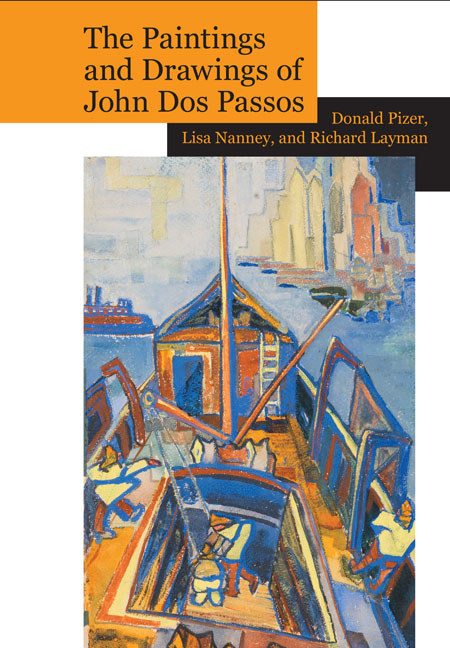Book contents
- Frontmatter
- Contents
- Preface
- Acknowledgments
- The Paintings and Drawings of John Dos Passos: A Collection and Study
- Introduction
- Paintings and Drawings Included in this Volume: A Descriptive List
- Preface to Section 1: Early Work 1918–20
- Preface to Section 2: The Middle East and Morocco 1921–22, 1926
- Preface to Section 3: Paris 1921–25
- Preface to Section 4: New York 1920–24
- Preface to Section 5: New York: Nudes 1920–23
- Preface to Section 6: Theater Designs 1925–28
- Preface to Section 7: Mexico 1926–32
- Preface to Section 8: Later Work 1930–70
- Preface to Section 9: Portraits
- Preface to Section 10: Sea Fronts and Harbors
- Preface to Section 11: Still Lifes
- Preface to Section 12: Studies in Motion
- Preface to Section 13: Abstractions and Other Experimental Modes
- Words and Images: The Visual Art of John Dos Passos
- The Artwork of John Dos Passos
- Notes
- Works Cited
- Index
- Plate section
Preface to Section 7: Mexico 1926–32
from The Paintings and Drawings of John Dos Passos: A Collection and Study
- Frontmatter
- Contents
- Preface
- Acknowledgments
- The Paintings and Drawings of John Dos Passos: A Collection and Study
- Introduction
- Paintings and Drawings Included in this Volume: A Descriptive List
- Preface to Section 1: Early Work 1918–20
- Preface to Section 2: The Middle East and Morocco 1921–22, 1926
- Preface to Section 3: Paris 1921–25
- Preface to Section 4: New York 1920–24
- Preface to Section 5: New York: Nudes 1920–23
- Preface to Section 6: Theater Designs 1925–28
- Preface to Section 7: Mexico 1926–32
- Preface to Section 8: Later Work 1930–70
- Preface to Section 9: Portraits
- Preface to Section 10: Sea Fronts and Harbors
- Preface to Section 11: Still Lifes
- Preface to Section 12: Studies in Motion
- Preface to Section 13: Abstractions and Other Experimental Modes
- Words and Images: The Visual Art of John Dos Passos
- The Artwork of John Dos Passos
- Notes
- Works Cited
- Index
- Plate section
Summary
As was true of his earlier Middle East paintings, Dos Passos's Mexican paintings of the late 1920s and early 1930s reveal a willingness to seek out vibrant ways of representing the uniqueness of the new world he was encountering. He spent considerable time during his 1926 visit in Mexico City, where he admired the work of the Mexican muralists, but he also visited several other cities and did much hiking in rural areas. His Mexican paintings, principally of villages, landscapes, and workmen, stem from his wanderings outside of major urban centers.
Present in almost all this work is Dos Passos's desire to capture the raw openness that he saw as the distinctive element in Mexican life. An isolated village, as in figure 38, Hill Village, mounts a hill side amidst a crudely shaped country-side, while in figure 39, Mexican Landscape, a threatening primitive landscape encroaches upon a thread of railway line and a single bright building. The natural world is only partly tamed in these paintings, a theme accentuated by Dos Passos's use of massiveness combined with heavy brush strokes and dark colors in representing it. An analogous directness is present in his portraits of this period. His Mexican fisherman (fig. 40) announces his occupation and character firmly and openly, staring directly at us. He is what he is, he appears to be saying. [DP]
- Type
- Chapter
- Information
- Publisher: Liverpool University PressPrint publication year: 2016



